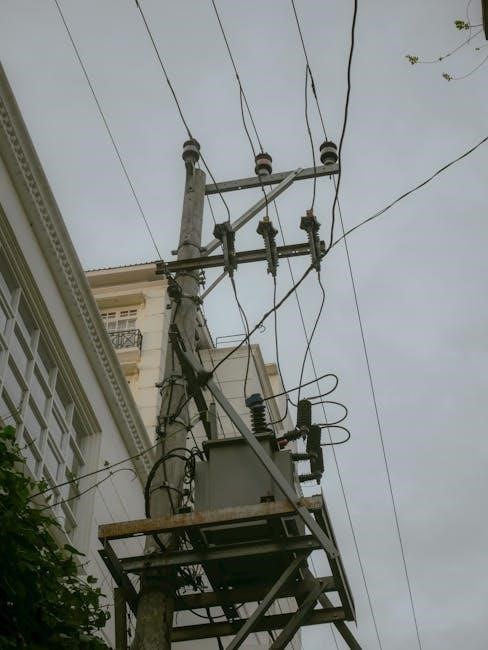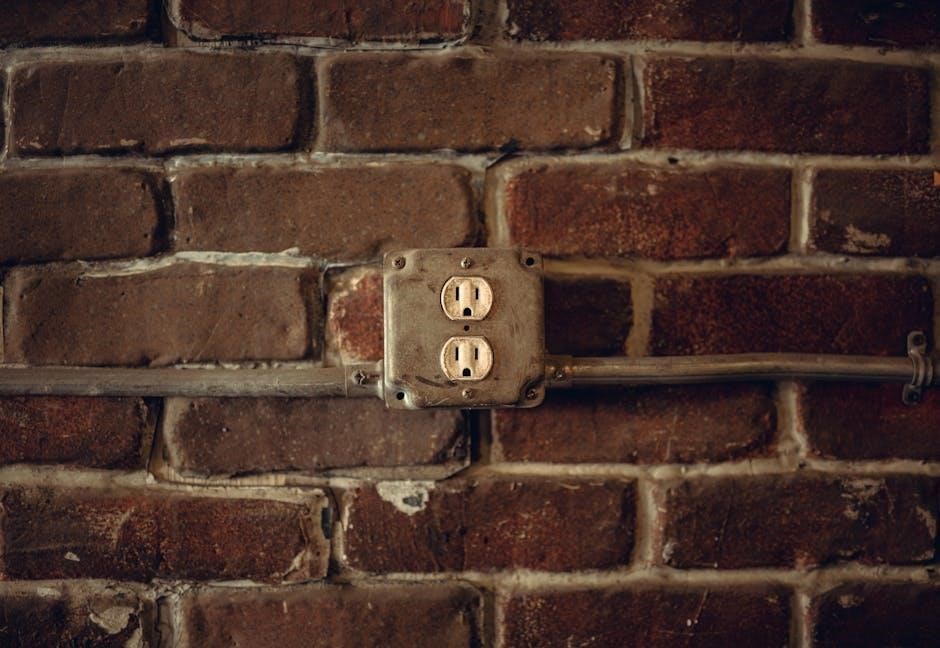Conduit bending is shaping pipes to route electrical wiring through buildings efficiently. This guide teaches essential techniques, tools, and safety tips for mastering the process effectively.
Overview of Electrical Conduit Bending
Electrical conduit bending involves shaping pipes to route wiring through buildings. Common bends include 90-degree turns, offsets, and back-to-back configurations. Hand benders are essential tools, while materials like EMT and PVC require specific techniques. Proper bending ensures safe, efficient installations, adhering to electrical codes and material requirements. This process is crucial for maintaining system integrity and functionality in various environments.
Importance of Proper Bending Techniques
Proper conduit bending ensures safe and efficient electrical installations. Accurate bends prevent wire damage, reduce installation time, and comply with NEC standards. Improper techniques can lead to system failures, safety hazards, and code violations. Mastering bending skills is essential for maintaining reliability, durability, and professional results in electrical projects. Adhering to guidelines ensures optimal performance and longevity of the electrical system.

Tools and Equipment for Conduit Bending
Proper tools ensure precise and safe bending. Hand benders, hydraulic benders, and heat benders are essential, along with measuring tools and dies for various conduit sizes and materials.
Hand Benders and Their Usage
Hand benders are essential for bending conduit, especially EMT, offering precision and control. They come in various sizes to fit different conduit diameters. Proper alignment and foot pressure ensure clean, kink-free bends. Always use the correct size bender to avoid damage. Mark the conduit accurately, align the arrow on the bender with the mark, and apply steady pressure for consistent results. Ideal for small to medium projects, hand benders are portable and cost-effective, making them a staple in every electrician’s toolkit. Refer to manufacturer guides for specific instructions and optimal performance.
Other Essential Tools for Bending
Beyond hand benders, heat benders are crucial for PVC and large conduits, ensuring proper flexibility. Measuring tools like tape measures and markers help accurately mark bend locations. Cutting tools, such as pipe cutters or saws, prepare conduit lengths. Workbench vices stabilize the conduit during bending, while take-up measurements ensure precise bends. These tools collectively enhance accuracy and efficiency in conduit bending tasks.

Step-by-Step Bending Process
Measure and mark the conduit, position the bender, and apply steady pressure to achieve precise bends. Follow detailed steps for accurate electrical conduit shaping.
Measuring and Marking the Conduit
Measure the desired stub height and subtract the take-up distance to determine the starting point for the bend. Mark the conduit clearly using a marker, ensuring accuracy. For PVC conduit, heat bending requires specific measurements, while EMT conduit uses a bender shoe. Proper marking ensures precise bends, avoiding errors during the bending process.
Positioning the Bender and Applying Pressure
Align the bender’s arrow with the marked point on the conduit, ensuring it is properly seated in the bender’s groove. Apply steady foot pressure on the pedal while holding the conduit firmly with both hands to maintain stability. This ensures a smooth, precise bend without kinking the conduit, achieving the desired angle accurately and safely.

Common Types of Conduit Bends
Conduit bends are categorized into 90-degree, offset, and back-to-back configurations. 90-degree bends change direction, offsets create Z-shapes to avoid obstacles, and back-to-back bends form U-shapes for continuous runs.
90-Degree Bends
A 90-degree bend is the most common type, used to change the direction of conduit runs. It is typically achieved by marking the conduit, positioning the bender, and applying steady pressure. Proper technique ensures smooth, kink-free bends, crucial for maintaining wire integrity and system safety. This bend is essential for routing conduit around corners and between walls and ceilings.
Offset Bends
An offset bend creates a Z-shape, allowing conduit to navigate obstacles or change elevation. It involves two 45-degree bends in opposite directions. Measure and mark the conduit, then bend at the marks using a hand bender. This technique is essential for complex installations, ensuring wires remain protected and routing stays efficient while avoiding structural hindrances.
Back-to-Back Bends
A back-to-back bend creates a U-shape in a single conduit length, ideal for routing across floors or ceilings before turning up or down a wall. It involves making two 90-degree bends in quick succession. This technique is useful for installations requiring a smooth transition between surfaces, ensuring continuous wiring pathways while maintaining structural integrity and code compliance.

Common Mistakes to Avoid
Common mistakes include incorrect measurements, using the wrong bender size, and applying insufficient foot pressure, leading to kinks or improper angles. These errors can compromise conduit integrity and code compliance.
Incorrect Measurement and Marking
Incorrect measurement and marking are common mistakes that lead to improper bends. Forgetting to subtract the take-up distance from the desired stub height results in bends that are too short. Additionally, misaligning the bender’s arrow with the mark can cause angles to be off, leading to kinks or uneven bends. Always double-check measurements and ensure precise alignment to avoid these errors, which can compromise conduit integrity and compliance with electrical codes.
Using the Wrong Bender Size
Using the wrong bender size can lead to improper bends, kinking, or uneven conduit alignment. A bender too small for the conduit may cause excessive force, damaging the pipe, while a bender too large may fail to hold the conduit securely. Always select a bender matching the conduit’s diameter to ensure precise, safe, and compliant bends, adhering to NEC standards and maintaining structural integrity.

National Electrical Code Compliance
The NEC governs conduit bending, ensuring safety and compliance. It specifies maximum allowable bends and minimum bend radius requirements to prevent damage and maintain electrical system integrity.
Maximum Allowable Bends
The National Electrical Code (NEC) specifies that the total conduit bends in a run must not exceed 360 degrees, equivalent to four 90-degree bends. This regulation ensures electrical systems remain safe and functional. Exceeding this limit can cause wire damage or installation failures. Proper planning and precise measurements are crucial to comply with NEC standards and maintain system integrity.
Minimum Bend Radius Requirements
The National Electrical Code (NEC) mandates minimum bend radii for conduit to prevent damage and ensure safe installations. For example, a 1/2-inch conduit requires a 4-inch radius, while a 1-inch conduit needs a 5-inch radius. These standards prevent excessive stress on wires and maintain system integrity. Always consult NEC guidelines for specific conduit sizes to ensure compliance and safety in electrical installations.

Different Materials and Their Bending Requirements
Various conduit materials, such as EMT, PVC, rigid, and fiberglass, have unique bending requirements. Each material demands specific tools and techniques to ensure proper shaping and durability during installation.
EMT Conduit
EMT (Electrical Metal Tubing) conduit is a popular choice for electrical installations due to its durability and flexibility. It requires precise bending techniques using hand benders or mechanical tools. To achieve accurate bends, measure and mark the conduit, then align the bender’s arrow with the mark. Apply steady foot pressure to form smooth, kink-free bends. Always subtract the take-up measurement from the desired stub height for precise results. Proper bending ensures reliable electrical connections and a professional finish.
PVC Conduit
PVC conduit requires heat bending, unlike EMT, using specialized heat benders for larger diameters. It offers corrosion resistance and flexibility, ideal for outdoor and harsh environments. Proper heating ensures smooth bends without cracking. PVC conduit meets UL 651 and ASTM D1784 standards, providing durability and safety in electrical installations. Always follow manufacturer guidelines for optimal results and compliance.
Rigid and Fiberglass Conduit
Rigid conduit is durable but challenging to bend, requiring specialized hydraulic or electric benders. Fiberglass conduit, made from epoxy resin, offers excellent corrosion resistance and flexibility. It bends more easily than rigid conduit, making it ideal for complex installations. Both types ensure long-lasting electrical systems, with fiberglass excelling in demanding environments due to its resistance to chemicals and moisture.

Advanced Bending Techniques
Advanced bending techniques involve complex offsets, multi-bend configurations, and heat bending for large conduits. These methods require precision and practice to ensure smooth, professional results.
Complex Offsets and Multi-Bend Configurations
Complex offsets involve bending conduit in multiple planes to navigate obstacles. Multi-bend configurations require precise planning, ensuring each bend aligns correctly. Using calculative methods and specialized tools, electricians achieve accurate results. These techniques are essential for intricate installations, ensuring electrical systems remain efficient and safe. Practice and experience are key to mastering these advanced bending skills effectively.
Using Heat Benders for Large Conduits
Heat benders are essential for bending large conduits, especially PVC, as they require softening for flexibility. Preheat the conduit to the recommended temperature, then carefully shape it using a bending template or form. Allow it to cool before handling. This method ensures smooth, kink-free bends for heavy-duty applications, adhering to safety and material specifications for optimal results.

Safety Precautions
Always wear protective gear, including gloves and safety glasses. Ensure the workspace is clear and stable. Properly secure the conduit to prevent accidents during bending.
Protective Gear and Workspace Preparation
Wear protective gear like gloves, safety glasses, and a dust mask to prevent injuries. Ensure the workspace is clear, well-lit, and free from obstructions.
Use a sturdy, flat surface for bending to maintain stability. Secure the conduit firmly to avoid accidental movement during the bending process.
Keep loose clothing and long hair tied back to prevent entanglement with tools. Regularly inspect tools for damage to ensure safe operation.
Best Practices for Safe Bending
Always use the correct bender size for the conduit to prevent damage or kinking. Apply steady, controlled pressure to avoid over-bending. Ensure the conduit is properly secured in the bender to maintain stability. Regularly inspect the bender and conduit for signs of wear or damage. Follow the manufacturer’s guidelines for optimal bending results and safety. Keep the workspace clean and well-organized to minimize hazards.
Mastering conduit bending requires precision, patience, and practice. Proper techniques ensure safe and efficient electrical installations, protecting both systems and personnel from potential hazards.
Summarizing Key Points
Conduit bending involves shaping pipes to route electrical wiring efficiently. Essential tools include hand benders and proper sizing for accurate bends. Measuring and marking are critical for precise results. Techniques vary for 90-degree, offset, and back-to-back bends. Adherence to NEC standards ensures safety and compliance. Proper bending prevents damage and ensures reliable electrical connections, requiring practice for consistent outcomes.
Encouragement to Practice and Master Techniques
Mastering conduit bending requires consistent practice and patience. As you refine your skills, you’ll achieve precise, professional results and ensure reliable electrical systems. Investing time in perfecting these techniques enhances your expertise, making complex installations more manageable and boosting your confidence as an electrician. Keep practicing to excel in this essential trade skill.
